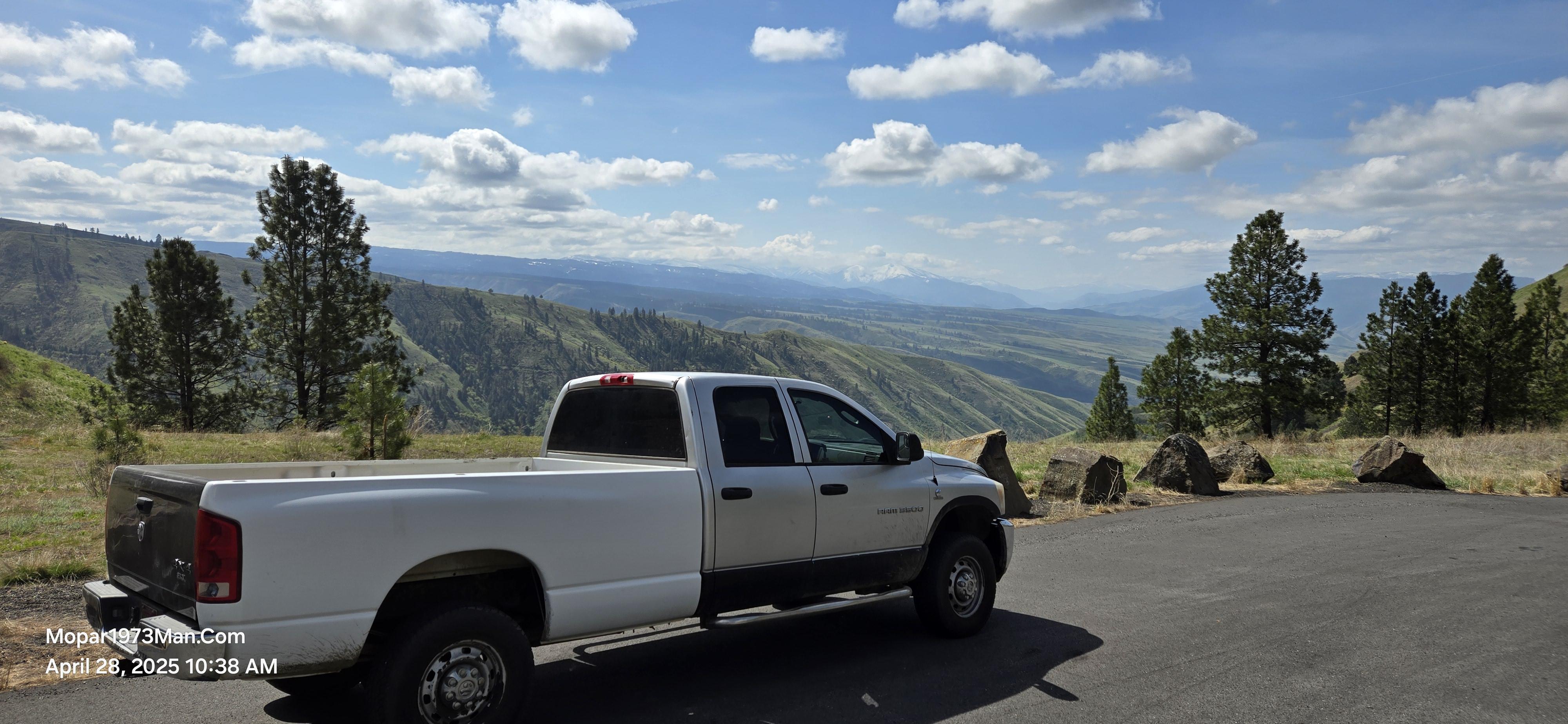
Everything posted by Mopar1973Man
-
New addition to the family!
Well we got a new addition to the family... Meet diesel! 3 Month old dobberman puppy... :thumbsup My new truck companion and security! B)
-
CAI... in winter?
Glad to see the idea works for you... I've see this idea with wood, plastic, metal, and aluminum... Just about anything you can cut out and place in the grill holes...I'd love to see some pics of your finished product though...
-
Synthetic 2 cycle oil usage.
Thank you Keydl... You covered my bases again! Thumbs up to you! :thumbsup I really do need to buy you a beer! As for the results of the HFRR testing done by DieselPlace.com is here... http://mopar.mopar1973man.com/cummins/general/2-cycle-oil/hfrr/hfrr.htm
-
Why Cummins is so tough...
They are connecting rods... They connect the piston to the crank. These have to withstand the pounding of the massive horsepower that a Cummins has! :thumbsup
-
Why Cummins is so tough...
Yeah I know its a old pic of this but is still points out one reason why a Cummins is so durable...
-
Resolutions????
Hmmm... Most of what MoparMaiden listed I could agree on! (2,3, and 4) :thumbsup Try and get my work done this spring so I can play this summer... B) (Firewood Etc.)
-
winter in the woods
MoparsMaiden got that right... Practice does make perfect. We both need to go out to a controlled area and try different things. So how much our trucks can do without aids like 4WD and chains...
-
Happy New Year
Well MoparsMaiden and myself had a wonderful New Years... Spent it together and had a very quiet New Years as well... :thumbsup
-
Mixing additives with 2 cycle oil...
Like i've shown above in my post that the two will average out. So consult the HFRR page and check the HFRR number of the product... You got to remember that some solvent type chemicals will cancel out the lubricity of the 2 cycle oil really fast... Like Naptha, mineral spirits, xylene are all great solvents that are used for cleaning. Look up the MSDS sheet for your product then look up the chemicals.. http://mopar.mopar1973man.com/cummins/general/2-cycle-oil/hfrr/hfrr.htm <- HFRR page http://mopar.mopar1973man.com/cummins/general/2-cycle-oil/msds/msds.htm <- MSDS Sheet viewforum.php?f=19 <- Extended MSDS Sheets Or look at the spreadsheet of it.. http://i143.photobucket.com/albums/r123 ... HFRR-2.jpg
-
Mixing additives with 2 cycle oil...
Not a problem... I got to keep passing the information out to the others... B) :thumbsup
-
Mixing additives with 2 cycle oil...
Well I've been asked about mixing other additive with 2 cycle oil quite a bit. I tend to tell everyone there is no need truely for the other additive. But lots of people still want to added a other product to the 2 cycle oil. I've got a rule of thumb that will help... Only mix 2 cycle oil with a lower HFRR additive to help improve the lubricity. If you mix with a higher HFRR number your lubricity will be greatly reduced. To show this just figure the average of the HFRR number of the products you want to mix... Like for example lots of people want to mix PowerService and 2 Cycle Oil. Let me show what happens to the HFRR number... PowerService --- 575 HFRR 2 Cycle Oil ------ 474 HFRR 474 + 575 = 1049 / 2 = 524 HFRR So you improved the Powerservice but you reduced the lubricity of the 2 cycle oil greatly. As matter of fact it now is at minimum standards! (520 HFRR) But lets try my rule of thumb... Using a better product... Opti-lube XPD --- 317 HFRR 2 Cycle Oil ------ 474 HFRR 474 + 317 = 791 / 2 = 395 HFRR You now sucessfully mixed to products together and gain the benefits of the second product with 2 cycle oil not to meantion you meet and exceed both standards. (Manufactures standards and US Gov't Standards!) You can use this same math to figure out more than 2 products... 2% Bio Diesel --- 221 HFRR Opti-Lube XPD -- 317 HFRR 2 Cycle Oil ------ 474 HFRR 474 + 317 + 221 = 1,012 / 3 = 337 HFRR Now I'm going to show a extreme... 2% Bio Diesel --------------- 221 HFRR Primrose Power Blend 2003 -- 711 HFRR 711 + 221 = 932 / 2 = 466 HFRR As long as you mix a strong lubricant with your additive it will pass the standards... Here is my table of HFRR results from the Diesel Place testing... http://i143.photobucket.com/albums/r123 ... HFRR-2.jpg Then here is athe table for mixing ratios and calculated HFRR per dose. This is based of Diesel Place.Com data... http://mopar.mopar1973man.com/cummins/general/2-cycle-oil/hfrr-calc/hfrr.htm
-
Cirrus heater motor... help pls.
It might snap on... But I would lghtly pry up on the cowling and look under and try to get a look at the fastners... Snaps, expanding screw (plastic), etc... :confused:
-
UPDATE! - August 14, 2007 - BTU values of fuels and chemical
Here you go... http://mopar.mopar1973man.com/cummins/general/2-cycle-oil/btu/btu.htm
-
Re-mounting a Frantz filter
Well I (think) I figured out a fix to the problem... LOL
-
Re-mounting a Frantz filter
Thank you... It wasn't really all that hard but there is a story behind it... No... I have to produce the steel bracket on the battery to mount the Frantz mounting to... The story behind it is... If you look closely at picture #2 you'll see I had to grind off my first attempt at mounting the Frantz filter. I forgot to remember the BHAF and intake tube. All I used was 2 angle brackets and welded them on to the Frantz mounting base. So on the second try. I used a piece of flat strap about 1 1/2" wide. And basically bent the two ends in a table vise using a hammer. Then I drilled two holes on each end. Had to trim the upper tab a bit with a hack saw. But after about 30 minutes of work I got me a nice bracket. This time I moved the Frantz base plate all the way foreward. Using the two bolt holes I bolted it to my new bracket... Which you can see in the last pic...
-
Re-mounting a Frantz filter
Well Gang... I finally got tired of the huge sloppy mess I would make while changing my Frantz Filter. It seems like every time I would lift the can off the TP roll would stick to the stem and the oil would drain everywhere down the fender. So I started looking at what I could do to change it and make it less messy... So here is mt new mounting... Here is a close up of my new battery mounting bracket... The other problem was even if I could get the filter off without the mess the stem tube would be still full of oil and this oil would be enough to darken the new oil in seconds. It would look like I never changed the oil... :wow But now with it up-side-down it will drain out completely into the lid of the filter now! Now when I change my oil next maybe I won't make a huge mess... :rolleyes
-
Cirrus heater motor... help pls.
Ok Russ... I went out to my Dodge motorhome and pop the wiper arm off in about 10-15 seconds... But here is the typical locking mechism... Locked position... Unlocked position... You must lift the wiper arm off the glass and slide the tabbed lock outwards them just lightly tug and there off! :thumbsup
-
Cruise Control
Well My Mom's 1996 Dodge Ram had some cruise control issues. Like you set the cruise and it would fade out. Well after digging under the battery tray and getting it un-bolted I managed to get it out in the open. When I inspected the plastic was rotten from the acid that drips from the battery tray. As you notice there is 2 holes. This was after I cleaned the blistered plastic off which was soft and easy to take off with your finger nail. Well that is for sure my vacuum leak for sure. But I could see something inside the hole and I didn't want to repair the cruise control and have something get damaged or jammed. So there is 2 tiny screw holding a cover plate on by the wiring plug. I used a pair of pilers to twist them out... But this is what I found... The vacuum controller. It just lightly pressed in to place. So with a small screwdriver you should be able to pry the vacuum controller out. Knowing I would like to make this repair last I took a piece of old ABS black plastic and heated it with hot screwdriver. This allowed me to tool the heat plastic around and get it to bind with the old plastic as well. As a matter of fact it took quite a bit of plastic to build it back up and make it strong again. As your working it you MUST check inside to be sure you haven't pushed any melted plastic inside. I used a smaller screwdriver and tooled the inside gently. But all in all it work out good... And now the corner is built up with new plastic. I took it out for a test drive and it work beautiful now! :thumbsup
-
Cirrus heater motor... help pls.
Ok Russ... I got a few to things to help out...1. The cowling at the base of the windshield is part of it. Remember that the water must drain out at a lower point so your going to have to pull the cowling cover up and look inside for a lower hole for drainage.2. As for the clean up you could duct tape a smaller hose ot the end of the vacuum to at least try and pull some more material out.3. As for the wipers ther are on a splined shaft typically. But most of them have some sort of locking device on it. Like a tab you have to lift or pry away from the wiper arm.I hope this helps you... Merry Christmas to you and your family! :thumbsup
-
Always be alert!
This little video clip is quite surprising![ame=http://www.youtube.com/watch?v=DDfZdfeJ1nc]http://www.youtube.com/watch?v=DDfZdfeJ1nc[/ame]
-
CAI... in winter?
Here is my setup...
-
banks exposed
Uh... Matty... Where is the link??? :confused:
-
CAI... in winter?
Mine I made by cutting a piece totally square and used a rasp file and rounded the cornere to fit... I never even bothered to remove to grill or anything... 8| Sound like time for the epoxy to come out for you... :confused:
-
Diesel Fuel Pour Point Depressant (MSDS)
After all that has been discussed its surprising what you find on the web about Pour point Depressants (PPD) or Anti-Gel products... :wow
-
Diesel Fuel MSDS sheet (Tesoro)
Here is a bit more information on diesel fuel... I found another MSDs sheet worth looking at... http://www.firstfuelbank.com/msds/diesel-total.pdf Just Below this is a MSDS for Diesel Treat (Schaeffers) 8|


